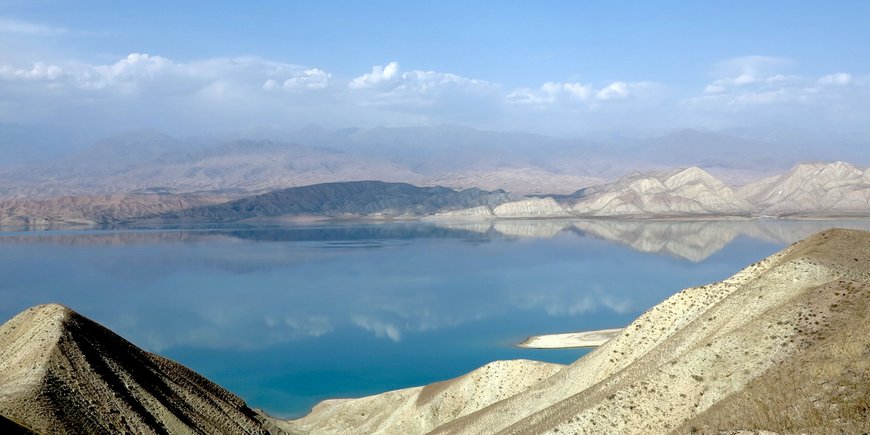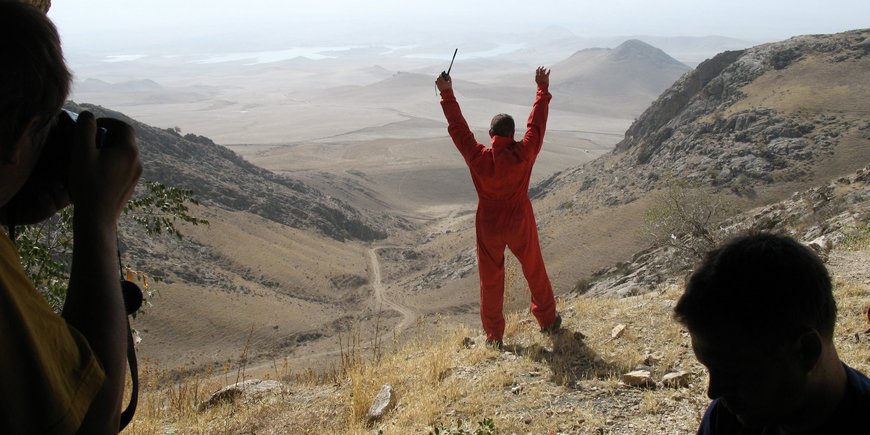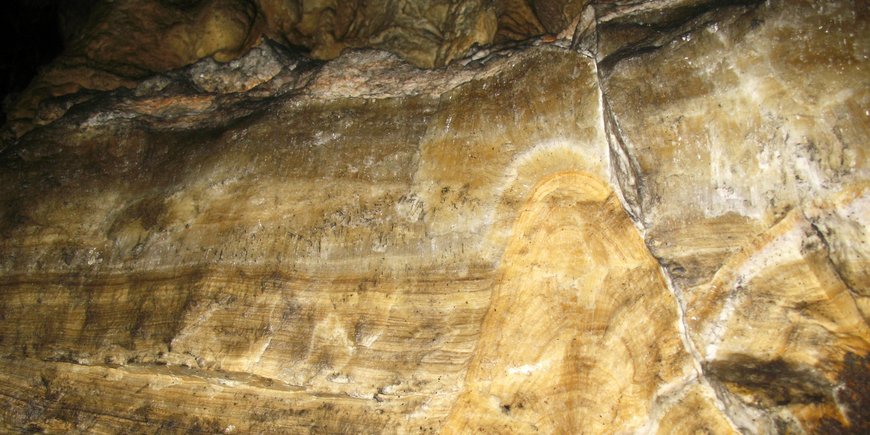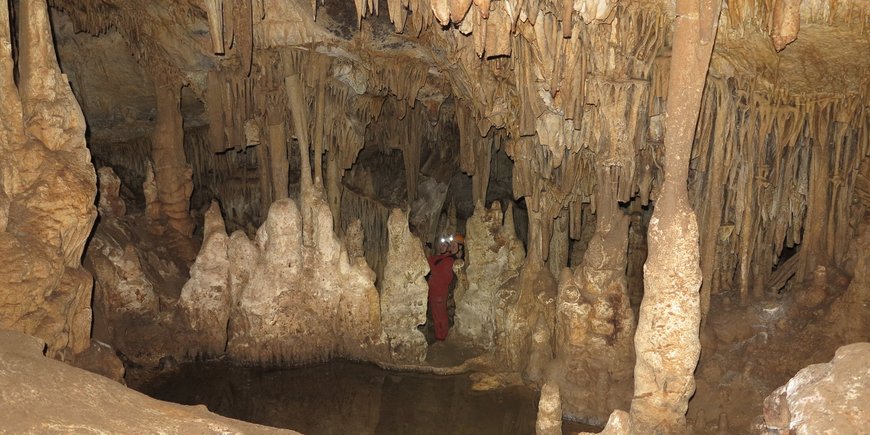Speleotheme und Monitoring
Änderungen der Niederschlagsmuster und der Temperaturen Zentralasiens haben einen direkten Einfluss auf die Wasserressourcen. Besonders die Region um das Fergana Tal ist hochempfindlich für Klimagefährdungen durch Dürre und Überschwemmungen.
Speleotheme (Tropfsteine) aus Höhlen bilden exzellente terrestrische Archive für paläoklimatologische Untersuchungen. Sie können sehr genau mit der U/Th bzw. 14C Methode datiert werden und enthalten eine Vielzahl umweltabhängiger Proxies. Mittels stabiler Isotope (δ13C, δ18O) und Spurenelementen können die Klimavariabilität und die hydrologischen Veränderungen der Vergangenheit rekonstruiert werden.
Grundlage für diese Untersuchungen ist das Verständnis der Isotope des rezenten Niederschlagsmusters sowie deren Eintrag in die Höhlen. Hierfür installierten wir ein Netz mit Niederschlagssammlern in Kirgistan und Loggern in geeigneten Höhlen für die ständige Messung von Temperatur und Feuchtigkeit.
Partner
Alexej Dudashvili (Foundation for Preservation and Exploration of Caves in Kyrgysztan)
Hai Cheng (University Minnesota, Xi'an Jiaotong University)
Jens Fohlmeister
Finanzierung
GFZ Potsdam, Focus Site Zentralasien
Publikationen
Fohlmeister, J., Plessen, B., Dudashvili, A. S., Tjallingii, R., Wolff, C., Gafurov, A., Cheng, H. (2017): Winter precipitation changes during the Medieval Climate Anomaly and the Little Ice Age in arid Central Asia. - Quaternary Science Reviews, 178, 24-36. https://doi.org/10.1016/j.quascirev.2017.10.026
Plessen, B., Helle, G. (2017): Vom Monitoring zum Klimaarchiv: Sauerstoffisotope in der Paläoklimatologie. - System Erde, 7, 1, 12-19. https://doi.org/10.2312/GFZ.syserde.07.01.2
Schwarz, A., Turner, F., Lauterbach, S., Plessen, B., Krahn, K. J., Glodniok, S., Mischke, S., Stebich, M., Witt, R., Mingram, J., Schwalb, A. (2017): Mid- to late Holocene climate-driven regime shifts inferred from diatom, ostracod and stable isotope records from Lake Son Kol (Central Tian Shan, Kyrgyzstan). - Quaternary Science Reviews, 177, 340-356. https://doi.org/10.1016/j.quascirev.2017.10.009
Wolff, C., Plessen, B., Dudashvilli, A. S., Breitenbach, S. F., Cheng, H., Edwards, L. R., Strecker, M. R. (2017): Precipitation evolution of Central Asia during the last 5000 years. - Holocene, 27, 1, 142-154. https://doi.org/10.1177/0959683616652711
Publikationen (Zentralasien)
Zhang, W., Mischke, S., Hosner, D., Zhang, C., Plessen, B., Li, H., Zhang, X. (2023): Late glacial and Holocene climate in the Kunlun Pass region (northern Tibetan Plateau) inferred from a multi-proxy lake record. - Quaternary International, 643, 46-60. https://doi.org/10.1016/j.quaint.2022.10.013
Börner, N., Jochum, K. P., Stuhr, M., Abstein, M., Plessen, B., Frenzel, P., Wang, J., Zhu, L., Schwalb, A. (2022): Late Quaternary changes in moisture availability and weathering intensity on the central Tibetan Plateau indicated by chemical signatures of ostracod shells. - Frontiers in Earth Science, 10, 826143. https://doi.org/10.3389/feart.2022.826143
Struck, J., Bliedtner, M., Strobel, P., Taylor, W., Biskop, S., Plessen, B., Klaes, B., Bittner, L., Jamsranjav, B., Salazar, G., Szidat, S., Brenning, A., Bazarradnaa, E., Glaser, B., Zech, M., Zech, R. (2022): Central Mongolian lake sediments reveal new insights on climate change and equestrian empires in the Eastern Steppes. - Scientific Reports, 12, 2829. https://doi.org/10.1038/s41598-022-06659-w
Kasper, T., Wang, J., Schwalb, A., Daut, G., Plessen, B., Zhu, L., Mäusbacher, R., Haberzettl, T. (2021): Precipitation dynamics on the Tibetan Plateau during the Late Quaternary – Hydroclimatic sedimentary proxies versus lake level variability. - Global and Planetary Change, 205, 103594. https://doi.org/10.1016/j.gloplacha.2021.103594
Mischke, S., Zhang, C., Plessen, B. (2020): Lake Balkhash (Kazakhstan): Recent human impact and natural variability in the last 2900 years. - Journal of Great Lakes Research, 46, 2, 267-276. https://doi.org/10.1016/j.jglr.2020.01.008
Mischke, S., Zhang, C., Liu, C., Zhang, J., Jiao, P., Plessen, B. (2019): The Holocene salinity history of Lake Lop Nur (Tarim Basin, NW China) inferred from ostracods, foraminifera, ooids and stable isotope data. - Global and Planetary Change, 175, 1-12. https://doi.org/10.1016/j.gloplacha.2019.01.017
Tarasov, P. E., Ilyashuk, B. P., Leipe, C., Müller, S., Plessen, B., Hoelzmann, P., Kostrova, S. S., Bezrukova, E. V., Meyer, H. (2019): Insight into the Last Glacial Maximum climate and environments of the Baikal region. - Boreas, 48, 2, 488-506. https://doi.org/10.1111/bor.12330
Alivernini, M., Akita, L. G., Ahlborn, M., Börner, N., Haberzettl, T., Kasper, T., Plessen, B., Peng, P., Schwalb, A., Wang, J., Frenzel, P. (2018): Ostracod-based reconstruction of Late Quaternary lake level changes within the Tangra Yumco lake system (southern Tibetan Plateau). - Journal of Quaternary Science, 33, 6, 713-720. https://doi.org/10.1002/jqs.3047
Heinecke, L., Epp, L. S., Reschke, M., Stoof-Leichsenring, K. R., Mischke, S., Plessen, B., Herzschuh, U. (2017): Aquatic macrophyte dynamics in Lake Karakul (Eastern Pamir) over the last 29 cal ka revealed by sedimentary ancient DNA and geochemical analyses of macrofossil remains. - Journal of Paleolimnology, 58, 3, 403-417. https://doi.org/10.1007/s10933-017-9986-7
Heinecke, L., Mischke, S., Adler, K., Barth, A., Biskaborn, B. K., Plessen, B., Nitze, I., Kuhn, G., Rajabov, I., Herzschuh, U. (2017): Climatic and limnological changes at Lake Karakul (Tajikistan) during the last ~29 cal ka. - Journal of Paleolimnology, 58, 3, 317-334. https://doi.org/10.1007/s10933-017-9980-0
Mischke, S., Liu, C., Zhang, J., Zhang, C., Zhang, H., Jiao, P., Plessen, B. (2017): The world’s earliest Aral-Sea type disaster: the decline of the Loulan Kingdom in the Tarim Basin. - Scientific Reports, 7, 43102. https://doi.org/10.1038/srep43102








